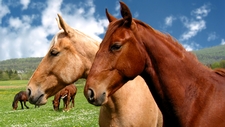Inherited Traits
Readiness

TEKS Objective
The student is expected to differentiate between inherited traits of plants and animals such as spines on a cactus or shape of a beak and learned behaviors such as an animal learning tricks or a child riding a bicycle.
Essential Understanding
The student knows that organisms undergo similar life processes and have structures that help them survive within their environments.
Science Background
It’s All About Birds: Museum of Science (PDF) - Illustrations of different beaks, feet and body shapes help to explain the inherited traits of birds. Can be used for background information or as a class activity.
It’s All About Birds
Museum of Science, www.mos.org
Cactus Spines: School of Biological Sciences at The University of Texas, Austin (website) - Use photos and text to explore many varieties of cactus spines—and their different functions—and to learn about the evolutionary conversion of leaves to spines in cacti.
Cactus Spines
The University of Texas at Austin, School of Biological Sciences, www.sbs.utexas.edu
What is a Trait? Genetic Science Learning Center (PDF) – Interactive tutorial on characteristics that are inherited and those that are learned or related to environment.
What is a Trait?
Genetic Science Learning Center, learn.genetics.utah.edu
Signature Lesson
Bird Beak Buffet: My Science Box (website) - Students imitate feeding birds by using various utensils (forks, spoons, etc.) to simulate different bird beak shapes, and then measuring the relative effectiveness of each “beak” in picking up food. This activity is based on Charles Darwin’s research on finches on the Galapagos Islands.
- Supporting Lessons
- Extensions
- Assessment Ideas
- Literature Connections
- Related
TEKS - Additional Resources
Supporting Lessons
An Inventory of My Traits: Genetic Science Learning Center (PDF) - Students inventory their own easily-observable, inherited genetic traits; identify how their traits differ from those of other fellow students; and record their observations on a class bar graph. Includes Spanish language student sheets.
An Inventory of My Traits
Genetic Science Learning Center, teach.genetics.utah.edu
Elaboration Lessons and Extensions
Family Traits Trivia: Genetic Science Learning Center (PDF) - In this take-home game/activity, students identify the shared and unique traits among their family members. Includes a Spanish language version.
An Inventory of My Traits
Genetic Science Learning Center, teach.genetics.utah.edu
Assessment Ideas
Develop a bank of questions about inherited traits and learned behaviors, and then hold a quiz show-style competition in which teams of students compete to answer questions.
Literature Connections
Who Was Charles Darwin? Hopkinson, Deborah (ISBN-13: 978-0448437644)
Traits and Attributes (Let’s Relate to Genetics). Hyde, Natalie (ISBN-13: 978-0778749660)
Charles Darwin (Giants of Science). Krull, Kathleen (ISBN-13: 978-0670063352)
Would You Survive? Animal and Plant Adaptation. Townsend, John (ISBN-13: 978-1410919694)
The Most Extreme Animals. Gerstein, Sherry (ISBN-13: 978-0787986629)
The Science Behind Animal and Plant Survival. Brasch, Nicolas (ISBN-13: 978-1599205595)
Additional Resources
Heredity & Traits: Genetic Science Learning Center (website) - Links to online slideshows, tutorials and other resources that provide information about heredity, traits and the science behind them.
Heredity & Traits
Genetic Science Learning Center, learn.genetics.utah.edu
Adaptations: Project Beak (website) - Different birds utilize different areas within their habitat. Learn about bird adaptations, including variations in feathers, beaks, feet and communication.
TEKS Navigation
Grade 5
Need Assistance?
If you need help or have a question please use the links below to help resolve your problem.

Comments